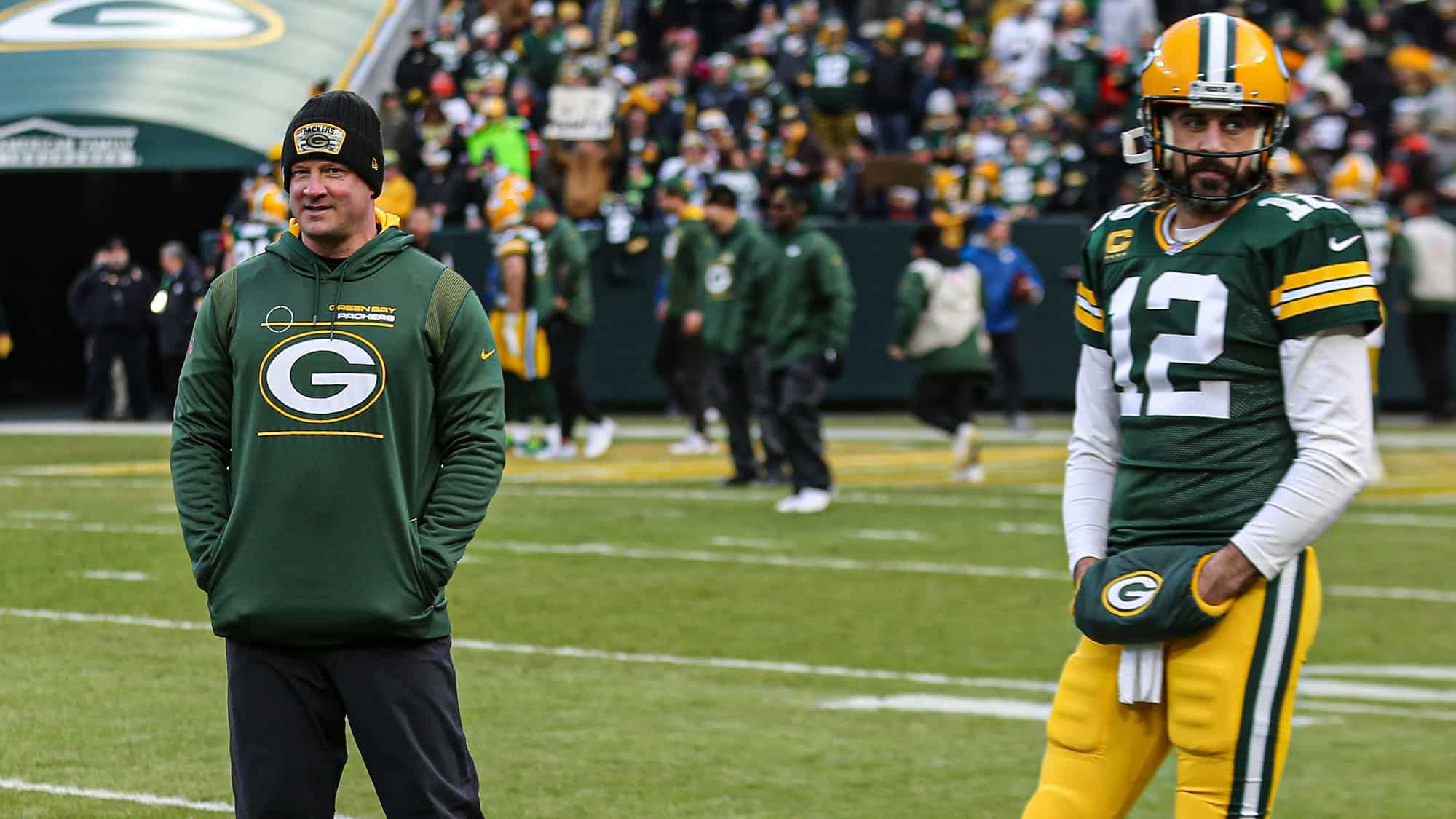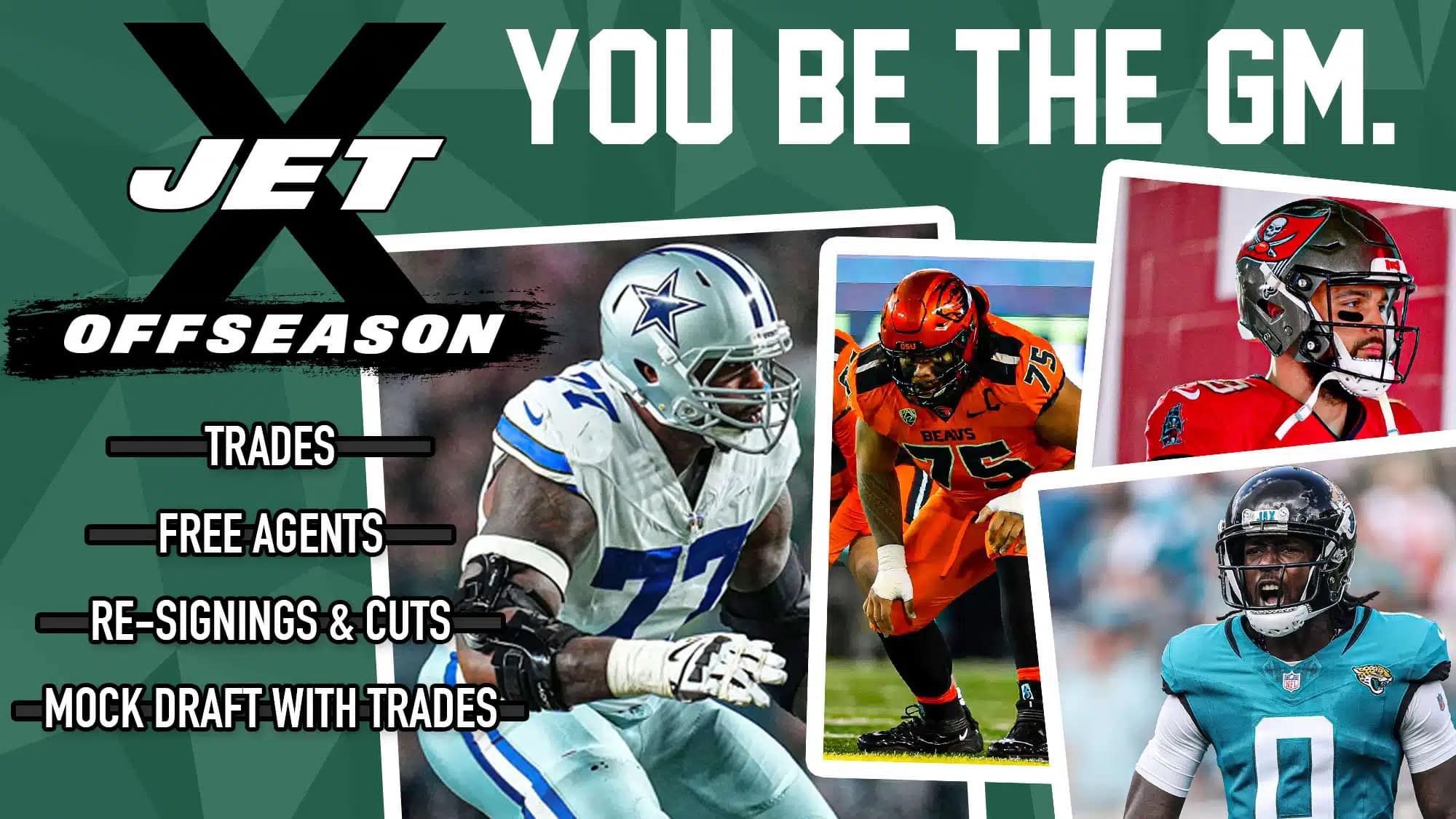Nathaniel Hackett got the best out of Aaron Rodgers. But how did he do it?
It’s hard to get the best out of an all-time great quarterback. Nathaniel Hackett is one of the few coaches who can say that he did.
Aaron Rodgers has played under five offensive coordinators over his 15 years as the starting quarterback for the Green Bay Packers. His best numbers came under Hackett.
Read More Jet X Content:
Article: Sauce Gardner dishes on idea of Aaron Rodgers joining NY Jets
Article: What level of OL play do NY Jets need to be successful?
Article: Nathaniel Hackett is perfect OC to unlock NY Jets RB Breece Hall
As the New York Jets presumably gear up for a pursuit of Rodgers, his success under Hackett is something to keep in mind. Rodgers seems to be on excellent terms with Hackett off the field, which is good for New York’s chances, but even more importantly, Rodgers likely thinks highly of what Hackett can do for him on the field as well.
Let’s dive into the numbers.
Traditional stats
Firstly, here is a comparison of Rodgers’ traditional box-score stats under each offensive coordinator.
| OC | Years | Passes | Passer Rating | Yds (Y/A) | TD (TD%) | INT (INT%) | TD:INT | Com% |
|---|---|---|---|---|---|---|---|---|
| Adam Stenavich | 2022 | 542 | 91.1 | 3695 (6.8) | 26 (4.8%) | 12 (2.2%) | 2.2 | 64.6 |
| Nathaniel Hackett | 2019-21 | 1626 | 109.2 | 12416 (7.6) | 111 (6.8%) | 13 (0.8%) | 8.5 | 67.1 |
| Joe Philbin | 2007-11, 2018 | 2679 | 103.4 | 21697 (8.1) | 157 (5.9%) | 39 (1.5%) | 4.0 | 64.9 |
| Edgar Bennett | 2015-17 | 1420 | 98.4 | 9924 (7.0) | 87 (6.1%) | 21 (1.5%) | 4.1 | 63.5 |
| Tom Clements | 2012-14 | 1362 | 108.9 | 11212 (8.3) | 94 (6.9%) | 19 (1.4%) | 4.9 | 66.4 |
Rodgers posted a 109.2 passer rating under Hackett, his best under any coordinator. This was fueled by his top-ranked marks in interception rate (0.8%) and completion percentage (67.1%) alongside his second-ranked touchdown rate (6.8%). Rodgers’ passer rating, touchdown rate, and interception rate were each ranked No. 1 in the NFL out of 25 qualified quarterbacks (min. 1,000 pass attempts) over the three-year span from 2019 to 2021.
Rodgers threw for his most yards per attempt under Joe Philbin and Tom Clements, suggesting those coordinators had Rodgers playing slightly more explosively than he did under Hackett. However, Rodgers’ incredible marks in completion percentage and touchdown-to-interception ratio under Hackett suggests Hackett had Rodgers playing his most consistent and efficient football by a wide margin – which is saying a lot considering Rodgers remains a highly efficient passer even when he is at his worst.
While Hackett played an integral role in building Green Bay’s offense, it’s important to note that head coach Matt LaFleur was the offensive play-caller throughout Hackett’s tenure as the OC. However, LaFleur’s predecessor, Mike McCarthy, was also the play-caller for most of his tenure as Rodgers’ head coach, so Hackett is being evaluated on the same plane as all of the other coordinators who coached Rodgers.
Play: 👉 the Jet X Offseason Simulator
In what specific areas did Hackett help Rodgers improve?
We can see that Rodgers apparently played his best football under Hackett, at least in terms of his traditional stats. Now, let’s figure out why that happened. In what specific areas did Rodgers play noticeably better under Hackett than he did under the other coordinators?
Short touchdown passes
One key area of improvement was Rodgers’ increased propensity for throwing short touchdowns. Rodgers stockpiled a ridiculous number of touchdown passes on short throws during his three years with Hackett. It served as the main reason Rodgers achieved his league-leading 6.8% touchdown rate under Hackett.
From 2019 to 2021, Rodgers hurled 44 touchdowns on throws that traveled 0-to-9 yards downfield. That ranked second-best in the league behind only Tom Brady (49).
This is a sizable spike compared to the rest of Rodgers’ career. Across his other 12 seasons as a starter, Rodgers threw 137 short touchdowns in 223 starts for an average of 0.614 per game (10.4 per 17 games). That is a far cry from the 44 short touchdowns he threw in 49 starts under Hackett – 0.898 per game and 15.3 per 17 games.
In 2022, his first season without Hackett, Rodgers threw only 6 short touchdowns. In 2018, his final season prior to Hackett’s arrival, he threw 8.
Hackett can be directly credited for Rodgers’ production in this area because he oversaw red zone game-planning during his time in Green Bay, famously renaming it the “gold zone” in honor of the movie “Austin Powers in Goldmember.”
Green Bay scored a touchdown on 67.2% of its red-zone trips in Hackett’s three years. After Hackett left, that number dropped to a 24th-ranked 51.9% in 2022.
Some of that decline can be attributed to the loss of star wide receiver Davante Adams (as can much of the decline for Rodgers and Green Bay in 2022), but the loss of Hackett certainly played a large role in the Packers’ red zone decline. The data clearly suggests Hackett has a knack for designing red zone concepts that work for Rodgers.
With or without Rodgers, Jets fans would love to see Hackett bring that “gold zone” wizardry to The Big Apple after watching their team rank 31st in red zone touchdown percentage (43.5%) under Mike LaFleur in 2022.
Quick-passing efficiency
During his time with Hackett, Rodgers’ completion percentage was up and his interceptions were down. This was made possible through Hackett and LaFleur’s ability to draw up high-percentage, low-risk opportunities for Rodgers in the quick game, which Rodgers converted upon with absurd efficiency.
In both 2020 and 2021, Rodgers had the NFL’s best passer rating on throws released in under 2.5 seconds, posting a mark of 127.7 in 2020 and 118.5 in 2021. These are the second and third-best marks of his career over the 12 seasons since this data started being tracked by PFF (dating back to 2011), trailing only his league-leading 138.2 rating in the 2011 season.
Rodgers’ passer rating on these throws dropped to 97.3 in 2022, tying Marcus Mariota for 18th out of 35 qualifiers.
Opening drives
Hackett helped Rodgers and the Packers consistently get off to scintillating starts.
From 2019 to 2021, Green Bay scored a touchdown on 19 of its 49 game-opening drives. That’s a rate of 38.8%, which ranked third-best in the NFL over that span. The Packers punted or turned the ball over on 44.9% of their game-opening drives (22 of 49), ranking fourth-best.
Green Bay crumbled in this area without Hackett in 2022. The Packers scored only one opening-drive touchdown (5.9%), tying the Jets, Ravens, and Colts for the league’s worst mark. They punted or turned the ball over on 52.9% of their opening drives (9 of 17), ranking 11th-worst.
The Packers ranked 17th with four opening-drive touchdowns in 2018, the season before Hackett arrived.
Aaron Rodgers and Nathaniel Hackett seem to be an ideal match
Rodgers’ stats under Hackett are impressive, but it’s not always a guarantee that the offensive coordinator has anything to do with a superstar quarterback’s production. Think back to Peyton Manning’s record-setting numbers under an up-and-coming Broncos coordinator whose name rhymes with Atom Place.
It’s important to dig deeper and see if there is any evidence that the coordinator was actually helping the quarterback rather than the other way around.
In this case, it does seem like Hackett truly did help Rodgers. There are a few different coaching-dependent areas in which Rodgers played better under Hackett than he did before or after Hackett’s tenure.
The play-calling and scheme own an enormous chunk of responsibility for the number of short touchdown passes thrown by the quarterback. Down in the red zone (ahem, gold zone), everything is tighter, and whether or not a player gets open often comes down to the quality of the play design rather than any player’s ability to create separation individually. A high percentage of red zone touchdowns are thrown to an uncovered receiver who broke free thanks to the play-call scheming him open.
If Rodgers’ uptick in total touchdowns was due to a boost in intermediate touchdowns and/or deep touchdowns, then it would be harder to credit Rodgers’ improved production to coaching, as those passes often require excellent execution and talent from both the quarterback and the receiver. But short touchdowns are largely the coaching staff’s responsibility.
Short touchdowns are an especially applicable tool for evaluating Hackett since it is a known fact that the red zone was at the forefront of his responsibilities in Green Bay.
When it comes to quick-game production, that’s another area you can comfortably attribute to coaching. If Rodgers’ performance boost under Hackett primarily came on long-lasting plays, it would be likely that he was just doing a better job of making things happen on his own – outside the structure of the offense. But for a quarterback to be successful on throws made in under 2.5 seconds, someone has to get open very quickly, and that cannot happen without good scheming.
Maximizing Rodgers’ quick-game efficiency is particularly important at this stage of his career. Rodgers’ arm talent and arm strength are still as special as ever, but his mobility is undoubtedly dwindling – look no further than the fact that his rushing-yards-per-game average has decreased in six consecutive seasons. It’s not wise to continue counting on Rodgers to be an off-script playmaker as he approaches 40. Hackett did a great job of building an offense that allowed Rodgers to thrive in-structure.
Finally, opening drives are certainly a part of the game that coaches can be credited for. Most fans know that coaches tend to “script” the first 15-to-20 plays of a game (I’ve sometimes heard 25), looking to build their first few drives around the opponent’s strengths and weaknesses before any in-game adjustments are made. Because of this, we know that a team’s first drive of the game is usually going to be completely premeditated, making it a strong indicator of the quality of the plan devised by the coaches throughout the week.
The Packers were one of the league’s best opening-drive teams during Hackett’s tenure. They were mediocre the season before he arrived and terrible the year after he left, even with head coach Matt LaFleur still in town.
Robert Saleh and the Jets’ brass will try to assure you that hiring Hackett had nothing to do with attracting any particular veteran quarterback. I’m not buying it. The evidence proves it: Nathaniel Hackett and Aaron Rodgers are a perfect match. I know it. The Jets know it. Rodgers knows it.
Now we all have to sit back and wait.
Will the Jets be able to lure in their biggest catch since Brett Favre?


